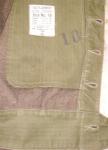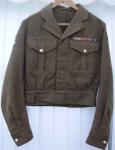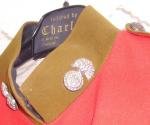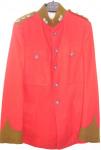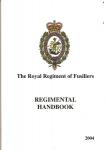-
Posts
1,065 -
Joined
-
Last visited
-
Days Won
1
Content Type
Profiles
Forums
Blogs
Gallery
Events
Store
Everything posted by Graham Stewart
-
A Lieutenant Colonels BD blouse dated 1949. The blouse actually belonged to Lt Col Phillipson and so work needs to be done to trace his service career. However I'm of the conclusion that he did actually serve with 43rd Royal Tank Regt during WWII. This had formerly been the 6th Bn, RNF before conversion to Tanks in 1938 and converted back to the infantry role as the 6th Bn, RNF IN 1956.
-
One of the unusual features of this jacket are the collar badges. O'Neill came from the ranks and as such held onto his one piece white metal collar badges, which have been silver plated, but are not the standard pattern for officers of NF,VB's, which were in two pieces - the strap & St.George being a seperate item. The badges themselves do appear to be in the wrong position also. However as they are sewn into the interior of the collar then they are no doubt genuine.
-
A scarlet officers patrol jacket belonging to Q.M. & Hon. Captain J. O'Neill, 2nd Volunteer Bn, Northumberland Fusiliers, who was promoted to that rank on the 7th November 1907. The jacket itself also bears the date in the tailors label of 3rd December 1907. This is probably one of my oldest and possibly the rarest uniform item in my collection and I'm very pleased to have it.
-
The silver shoulder board & gold wire Major's rank insignia. What appears to be missing is the special silver screw button with it's holder, but to be honest just to have one of these jackets is a collectors blessing. Sadly the padded interior has been ripped out and I suspect it's because the previous owner may have become slighly portly in later years. Todate I've been unable to identify the owner.
-
At long last am able to add some new items here and to begin with a Majors scarlet jacket belonging to either a Volunteer or Territorial Battalion. The difference being that all of the lace contained within the jacket has a high silver content hence the blaklish colour, plus there are the sliver plated buttons. Also distinguishing it from a regular officers pattern is the unique silver bullion collar badges, with gilt St.George & Dragon. Apologies for the photo quality but we have a crap camera.
-
To-date I can find no reference as to the originality of the grenade being associated with the artillery. The earliest references relate to the grenade actually being used on the Grenadier caps of the Grenadier Company since 1648. In the cases I've seen where this cap is described("The Fifth Fusiliers & it's Badges" by D.Wood), they are described thus;- c.1648-1768 - Grenadier Company - Soldiers. "Embroided cloth grenadier cap edged white originally, but later edged with fur. The green front carries St.George in worsted crewel work facing left. St.George wears golden armour, the horse is white and the dragon is green, with red tongue, all on a yellow patch. There are white scrolls with green leaves. Above St.George is a crown in full colours below a white and green pom-pon. Below the dragon is a red flap bearing a white worsted Hanoverian horse and motto "Nec Aspera Terrent" (Difficulties Do Not Daunt). The back of the cap is red with white piping and it's green turn-up carries white leaves and a "grenade, the ball carrying the numeral V". The bottom edge of the cap is bound with green and white bias." 1768 - (?) - Grenadier Company "On the front of the black bearskin cap, the Kings crest of lion and crown in silver plated metal on a black ground with the motto "Nec Aspera Terrent". On the back of the cap a "grenade with the regimental number(5) on the ball", and the badge of St.George in white set on the near top." Denis dedicated his life to looking for examples of badges worn by the Northumberland's, and although he isn't specific as to why the 5th adopted the grenade, I would think it would be safe to say that it was to identify their Grenadier's from those of other foot regiments, as in both cases a grenade and numeral(V or 5) are used on the rear of the caps. The Drummers, Fifers and Pioneer's who also wore the same cap, only bear the regimental number(5) to identify them. The Light Company wore the light cap emblazoned with St.George. Apologies if this doesn't answer your question, but by May 1836 on becoming Fusiliers, the grenade seemed to be worn universally throughout the regiment.
-
Having not been in the UK for the last four months, I haven't been able to add to this thread. However now that I'm back I can now add this one. The RRF Regimental Handbook dated 2004 and what an informative book it is, not unlike regimental "Standing Orders". Very, very pleased to get my hands on this one.
-
Noor Anything Victorian with signatures on, for the British Army and especially regimental is well worth the money. If it had been Northumberland Fusiliers I'd have been chasing you to see if you were prepared to sell it. On the plus side for this one you can determine who the characters involved are, probably without much effort, all you would need is the Army List for 1894
-

Trench Maps
Graham Stewart replied to pjac's topic in Great Britain: Research, Documentation & History
Yes they are collected and I believe one lad bought up loads of them and devised a GPS system which you allowed to follow them accurately for war walks etc. -
No.7247 C. in .C's Office Fort William 27th Dec 1894 Copy of a letter from Military Secretary, H. Gds(Horse Guards) to H. E. the C. in C. in India, No.107/102/65 ? War Office 28th November 1894. I am directed by H.R.H. the C. in C. to acknowledge receipt of your letter of the 27th ulto, & to aquaint you in reply that H.R.H. does not consider the reasons given by Captn A.M. Horrocks, 2nd R. Dub Fus sufficient to justify his being promoted provisionaly. Forwarded for Information Sig J. Hamilton Col Mily Secty True copy forwarded for info B.O. ?/1/95 ? ? Captain Adjutant, 2nd R. Dub Fus To Captain A.M. Horrocks 2nd R. Dub Fus
-
I did wonder why I couldn't see any on the strap and my other thought was perhaps one of the senior ranks, but wasn't certain if they only trimmed their collars with gold lace as in the line infantry. I would say both the collar badges are gold bullion and the collar, gold lace. My dad was Grenadiers and so the buttons were the give away, as I still have his. Guards dress and distinctions are very much different from infantry of the line and to be honest I find the infantry easier to identify.
-
Second photo a bit harder to determine. For my money definately a soldier, but what unit? His jacket appear to be a seven button frock coat, but I can't tell whether he has distinguishing facing's on either the collar and cuff. He certainly has no collar badges and the cuff itself appears to be the "jam-pot" type, which disappears c.1902 in favour of a pointed cuff. However what he does have is a distinguishing shoulder strap, which is piped all of the way around and not many regiments had full piping on the strap of the frock coat, which could help narrow the unit down. Problem is we can't make out the unit title on the strap. His belt appears to be the Slade/Wallace type, with an unusual buckle, as it doesn't appear to the general service pattern buckle. All in all a nice period photo, but not enough detail to give us the regiment.
-

pre WW1 three place medal bar
Graham Stewart replied to Noor's topic in Great Britain: Orders, Gallantry, Campaign Medals
There was a Mediteranaen Cruise by the Royals in 1899 which lasted from March to May.


